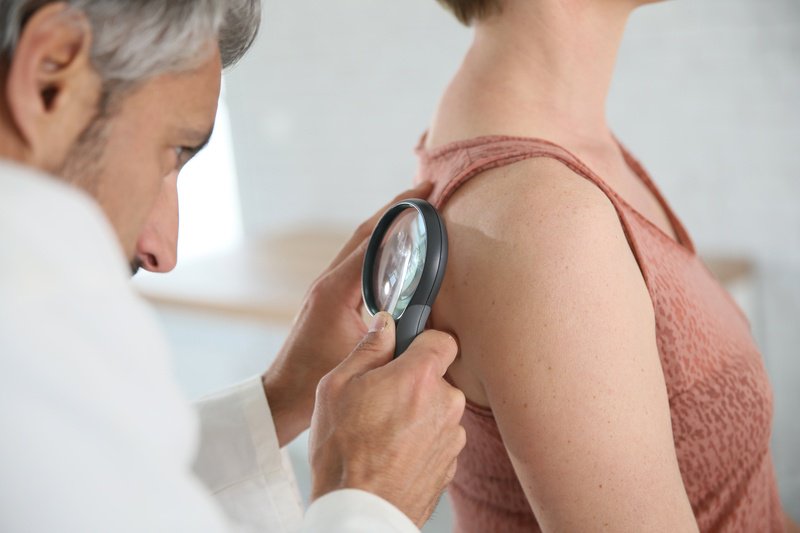Each year approximately 96 percent of the million newly diagnosed skin cancer cases in the U. S. are basal cell or squamous cell carcinoma. When treating these cancers, Mohs has impressive cure rates of more than 99 percent for new skin cancer and 95 percent for those that recur.
Mohs is successful in treating larger tumors and those with ill-defined edges. For lesions near the nose, eyes, ears, forehead, scalp, fingers and genital area, Mohs is especially recommended. Recurring cancer responds well to Mohs surgery, too.
Is Mohs the Best Choice?
Fifty years ago at the time, the concept of Mohs surgery was developed, there were few doctors trained in the procedure. Today Mohs is used by dermatologists throughout the world, recognized as a precise and preferred treatment for skin cancers.
Tumors recurring after treatment are successfully removed with Mohs. Although skin cancers may be clearly seen by the patient, tiny cancer cells that are microscopic or cells not removed can make the cancer reappear. It’s possible that the tumor goes past the external areas with groups of cells extending into other areas.
With the Mohs technique, these cells can be identified and removed with a high degree of accuracy and extremely high cure rates from 95% to 99%. A board-certified dermatologist who is expertly trained in the Mohs procedure should be the one to decide if the procedure is your best option and will advise if optional procedures are preferred.
How Mohs Surgery Is Performed
Few tumors grow in a symmetrical pattern. At the surface level, the tumor may actually be only a portion with more that exists under the skin. Because there are variations of tumor growth that are best treated using the Mohs technique, it is important to understand the details of the surgery. The Mohs technique includes the following:
- Excising a tumor using strict anatomical orientation.
- Close examination of tissue using a microscope.
- Mapping the exact location of the residual tumor for complete removal of skin cancer.
First, multiple thin, portions of excised tissue are analyzed. Tumors may send appendages of malignancy below the skin surface, beyond visibility. The high level of microscopic control sets Mohs apart from alternative procedures for skin lesion removal.
The precision removal of the tumor is performed with a margin of healthy tissue around and below the lesion. Each level of tissue is intensely reviewed and “plotted” by the surgeon, so its precise region can be noted and isolated. Portions of tissue that are removed are carefully inspected under the microscope for evidence of any cancer cells.
Any evidence of cancerous tissue within the specimen is identified and removed. The surgeon proceeds to take away tissue until there are no cancerous cells present in the extracted specimen. Because of the close microscopic examination of each layer, dermatologists can be certain of the cancer eradication. The cancerous cells only are removed, preserving normal tissue at every turn.
“The fact that cure rates for Mohs surgery are so high is an advantage for both patients and physicians. Offering a proven procedure to my patients that will eradicate their skin cancer is very gratifying.”
– Jessica Scruggs Dorsey, MD, FAAD, Fellowship-trained Mohs Surgeon, Board-Certified Dermatologist, Dermatology Associates of Central Texas, Georgetown
Why Choose Mohs Surgery?
Cure rates for skin cancer after treatment with Mohs surgery are as high as 95% to 99%. The technique results in a minimal wound offering better healing and aesthetics. This is particularly important in areas such as the face and neck.
An overwhelming majority of tumors can be totally removed in one treatment session, due to the preciseness of the surgery and microscopic inspection. While the Mohs surgery is a technically demanding procedure, it is also highly cost-effective, because fewer return visits to the dermatologist´s office are needed for treatment of a recurring lesion.
Your Mohs Surgeon’s Qualifications
Doctors who practice and perform Mohs surgery have expert skills in dermatology, dermatologic surgery, and Mohs surgery. Ask your Mohs surgeon for details about their training and professional affiliations.
Looking to See a Mohs Surgeon?
High cure rates for Mohs makes the procedure an appealing choice for skin cancer treatment. However, it’s important to discuss your health history and other factors with your Mohs surgeon, dermatologist or physician to be certain it is your best option. There are other skin cancer options besides Mohs surgery that are also effective. We have multiple locations throughout the country, so fill out our simple online form to get in touch with us. One of our local team members will reach out to you shortly to answer your questions or schedule an appointment for you to visit us soon.
Find a location near me
or

